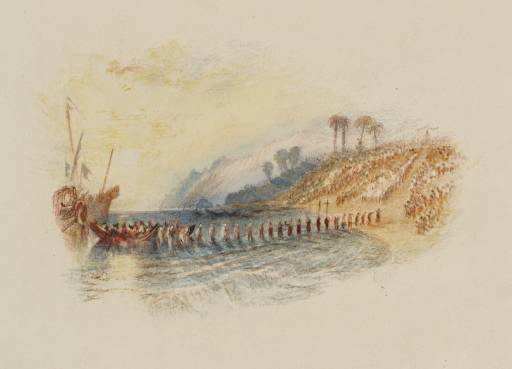Joseph Mallord William Turner The Landing of Columbus, for Rogers's 'Poems' c.1830-2
Joseph Mallord William Turner,
The Landing of Columbus, for Rogers's 'Poems'
c.1830-2
Joseph Mallord William Turner 1775–1851
The Landing of Columbus, for Rogers’s ‘Poems’ circa 1830–2
D27708
Turner Bequest CCLXXX 191
Turner Bequest CCLXXX 191
Pencil and watercolour, approximately 95 x 137 mm on white wove paper, 181 x 245 mm
Stamped in black ‘CCLXXX 191’ bottom right
Stamped in black ‘CCLXXX 191’ bottom right
Accepted by the nation as part of the Turner Bequest 1856
Exhibition history
1904
National Gallery, London, various dates to at least 1904 (249).
1936
Four Screens, British Museum, London, July 1936–February 1937 (no catalogue but numbered 8).
1963
Turner Watercolors from The British Museum: A Loan Exhibition Circulated by the Smithsonian Institution, National Gallery of Art, Washington DC, September–October 1963, Museum of Fine Arts of Houston, Texas, November 1963, M.H. de Young Memorial Museum, San Francisco, December 1963–January 1964, Cleveland Museum of Art, Ohio, January–March 1964, William Rockhill Nelson Gallery of Art, Kansas City, Missouri, March–April 1964, Brooklyn Museum, New York, May 1964, National Gallery of Canada, Ottawa, June–July 1964 (52).
1983
J.M.W. Turner: Dibujos y acuarelas del Museo Británico, exhibition catalogue, Museo del Prado, Madrid, February–March 1983 (41, reproduced).
1993
Turner’s Vignettes, Tate Gallery, London, September 1993–February 1994 (25, reproduced).
References
1903
E.T. Cook and Alexander Wedderburn (eds.), Library Edition: The Works of John Ruskin: Volume I: Early Prose Writings 1834–1843, London 1903, pp.233, 244.
1904
E.T. Cook and Alexander Wedderburn (eds.), Library Edition: The Works of John Ruskin: Volume XIII: Turner: The Harbours of England; Catalogues and Notes, London 1904, pp.380–1.
1906
E.T. Cook and Alexander Wedderburn (eds.), Library Edition: The Works of John Ruskin: Volume XXI: The Ruskin Art Collection at Oxford, London 1906, p.214.
1909
A.J. Finberg, A Complete Inventory of the Drawings in the Turner Bequest, London 1909, vol.II, p.903, as ‘Landing in America’.
1963
Edward Croft-Murray, Turner Watercolors from The British Museum: A Loan Exhibition Circulated by the Smithsonian Institution, exhibition catalogue, National Gallery of Art, Washington DC 1963, p.20 no.52.
1966
Adele Holcomb, ‘J.M.W. Turner’s Illustrations to the Poets’, unpublished Ph.D thesis, University of California, Los Angeles 1966, pp.94–5.
1979
Andrew Wilton, The Life and Work of J.M.W. Turner, Fribourg 1979, p.444 no.1206.
1983
Lindsay Stainton and Andrew Wilton, J.M.W. Turner: Dibujos y acuarelas del Museo Británico, exhibition catalogue, Museo del Prado, Madrid 1983, p.60 no.41, reproduced.
1992
Jan Piggott, ‘Turner’s “Columbus” Vignettes’, Turner Society News, no.61, August 1992, p.12.
1993
Jan Piggott, Turner’s Vignettes, exhibition catalogue, Tate Gallery, London 1993, p.85 no.25 reproduced, 97.
This is one of seven illustrations that Turner produced for ‘The Voyage of Columbus’, a miniature epic poem which is the final work in the published volume of Rogers’s Poems (for a brief description of the poem, see Tate D27705; Turner Bequest CCLXXX 188). The seven vignettes in order of their appearance in Rogers’s text are: Tate D27705, D27706, D27714, D27707, D27708, D27719, D27709; Turner Bequest CCLXXX 188, 189, 197, 190, 191, 202, 192.
Long on the deep the mists of morning lay,
Then rose, revealing, as they rolled away,
Half-circling hills, whose everlasting woods
Sweep with their sable skirts the shadowy floods:
...
Slowly, bare-headed, thro’ the surf we bore
The sacred cross, and, kneeling, kissed the shore.
But what a scene was there? Nymphs of romance,
Youths graceful as the Faun, with eager glance,
Spring from the glades, and down the alleys peep,
Then head-long rush, bounding from steep to steep,
And clap their hands, exclaiming as they run,
“Come and behold the Children of the Sun!”
(Poems, pp.251–2)
Then rose, revealing, as they rolled away,
Half-circling hills, whose everlasting woods
Sweep with their sable skirts the shadowy floods:
...
Slowly, bare-headed, thro’ the surf we bore
The sacred cross, and, kneeling, kissed the shore.
But what a scene was there? Nymphs of romance,
Youths graceful as the Faun, with eager glance,
Spring from the glades, and down the alleys peep,
Then head-long rush, bounding from steep to steep,
And clap their hands, exclaiming as they run,
“Come and behold the Children of the Sun!”
(Poems, pp.251–2)
The Landing of Columbus echoes the composition of an earlier illustration, A Vision (see Tate D27714; Turner Bequest CCLXXX 197) mirroring the line of ominous warrior spirits with the procession of Columbus’s crew onto the shore. Columbus’s act of bringing Christianity to the ‘New World’ is literally acted out by the two cross-bearing figures near the head of the line. Edward Goodall’s son, Frederick, believed that these figures were re-drawn by Stothard for the engraved version, although the close similarity between the print and Turner’s watercolour seems to suggest he was mistaken.3 The joyful and providential tone of the scene is highlighted in the watercolour by Turner’s brilliant palette, particularly the preponderance of shimmering golden colour. As Jan Piggott has observed, Rogers’s description is set in the morning and that Turner’s image is meant to show the moment when ‘the sun of faith symbolically rises on the New World’.4
Turner produced three preparatory studies for this vignette (see Tate D27711, D27529, D27616; Turner Bequest CCLXXX 194, 12, 99). Another related sketch may be Tate D27585; Turner Bequest CCLXXX 68. Furthermore, Turner also made two tiny thumbnail drawings of landscapes in the margins of Canto IX in his working copy of the 1827 edition of Poems (see Tate D36330; Turner Bequest CCCLXVI p.268).
Verso:
Inscribed by unknown hands in pencil ‘2[?7 or 6] | b’ top right and ‘CCLXXX.191’ bottom centre
Stamped in black ‘CCLXXX 191’ centre
Stamped in black ‘CCLXXX 191’ centre
Meredith Gamer
August 2006
How to cite
Meredith Gamer, ‘The Landing of Columbus, for Rogers’s ‘Poems’ c.1830–2 by Joseph Mallord William Turner’, catalogue entry, August 2006, in David Blayney Brown (ed.), J.M.W. Turner: Sketchbooks, Drawings and Watercolours, Tate Research Publication, December 2012, https://www

